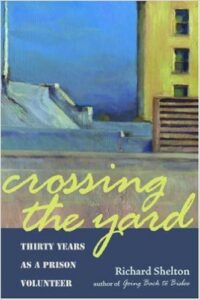Category: Diversity
-
Learning Together To “Get It Right”
By Elizabeth Watkins Price
Originally published at the North Carolina Criminal Law blogSince its founding in 2005, the mission of the Judicial College has been to provide “education and training to judicial branch personnel to develop the abilities and values necessary to provide justice.” In the nearly four years that I have been in my role, I’ve consistently encountered a similar dedication to learning and fairness expressed by our clients: the judges, magistrates, clerks, and other court officials of North Carolina. The great news is that the individuals who make up our judiciary are working hard to do incredibly complicated and difficult jobs, and they want to “get it right.” So, when we zoom out and see that the system we’re working in has a disparate impact on different communities, it can be hard to understand how our best efforts aren’t adding up to the creation of the fair and just system we all want to be a part of.
The murder of George Floyd and subsequent protests have shone a light on how structural inequalities and systemic racism can still distort good people’s best efforts. It is worth keeping in mind that while some aspects of this cultural moment may seem extreme, the central goal is a modest one about improving human lives in this country, a goal consistent with the broader mission at the School of Government, where the Judicial College is housed: “to improve the lives of North Carolinians by engaging in practical scholarship.” The second clause of this mission statement is key—the need for ongoing, engaged scholarship. Indeed, when our Dean, Mike Smith, blogged about the recent swell of awareness regarding race and equity in our country, he stressed the vital importance of actively enlarging on our own understanding of these issues as an essential means of supporting the work being done on this subject by the leaders of North Carolina.
We are all at different places in our learning and awareness about these subjects. We all have to begin where we are. This moment in American history calls us to move beyond where we’ve been, and we invite you to boldly explore the resources that suit your learning needs. This is the first step. As we move forward in our learning and reflection, it can be tempting to feel like we’ve made progress – and we have. But that internal growth becomes valuable only to the extent that it supports us in taking the next step: using that knowledge to inform us as we choose actions that lead
North Carolina and our justice system toward becoming the fair and just one – for us all – that we aspire to, one that really does “get it right.”To this end, over the last tumultuous month, our colleagues and our clients have been engaging in new conversations about questions of diversity, fairness, and access. The goals of these conversations range from reflection to courseplanning; from learning to leading. The more some of us learn about these subjects, the more we realize we don’t know. Nevertheless, this is not a new conversation, so there is an enormous amount of scholarship available to us as we each consider where and how to dig in.
The following is a list of resources that may help those looking to take that crucial first step.
Books about Fairness and Access in Justice System
- Locking Up Our Own: Crime and Punishment in Black America by James Forman Jr.
- Race, Racism and American Law by Derrick A. Bell
- The Color of Law by Richard Rothstein
- Minding the Law by Anthony G. Amsterdam and Jerome S. Bruner
- Just Mercy: A Story of Justice and Redemption by Bryan Stevenson
- The New Jim Crow: Mass Incarceration in the Age of Colorblindness by Michelle Alexander
Books about Race in America
- So You Want to Talk About Race by Ijeoma Oluo
- I’m Still Here: Black Dignity in A World Made for Whiteness by Austin Channing Brown
- Racism Without Racists: Color-Blind Racism and the Persistence of Racial Inequality in America by Eduardo BonillaSilva
- How To Be An Antiracist by Ibram X. Kendi
Critical Race Theory Journals
- Berkeley Journal of African American Law & Policy
- Columbia Journal of Race and Law
- Georgetown Journal of Law & Modern Critical Race Perspectives
- Harvard Civil Rights-Civil Liberties Law Review
- Journal of Gender, Race, and Justice
- The Law Journal for Social Justice (Arizona State)
- Michigan Journal of Race and Law
- Rutgers Race and the Law Review
- University of Miami Race and Social Justice Law Review
- Washington and Lee Journal of Civil Rights and Social Justice
Podcasts
- Scene on Radio Season 2, “Seeing White”
Scene on Radio is the Peabody-nominated podcast from the Center for Documentary Studies at Duke University dives into questions about the renewed embrace of white-identity politics, racial inequity in schools, housing, criminal justice, and more. Episode times vary from around 30-46 minutes each. - Code Switch
From NPR, this is a series of conversations about race and how it impacts every part of society — from politics and pop culture to history, sports and everything in between. - 1619
The Pulitzer Prize winning 1619 Project was developed by New York Times Magazine in 2019 with the goal of reexamining the legacy of slavery in the United States and timed for the 400th anniversary of the arrival of the first Africans in Virginia.
Videos Streaming Now
- Just Mercy, the film adaptation of the book by Bryan Stevenson is currently streaming on Amazon Prime.
- 13th is a 2016 Netflix documentary film by director Ava Duvernay, which explores the intersection of race, justice, and mass incarceration in the United States
- PBS News Reel’s RACE: The Power of an Illusion.
Organizations
- REI blogs/studies
- Othering & Belonging Institute at Berkeley
- Ohio State’s Kirwan Institute for Study of Race & Ethnicity
- Alamance Racial Equity Alliance (A.R.E.A.)
- CORE (Chatham Organizing for Racial Equity)
- Neighbors for Better Neighborhoods in Winston Salem
- OAR Orange County, Durham and Wake Organizing Against Racism
- Racial Equity Cabarrus
Other Reading Lists
- Duke University School of Law’s Resources on Race, Oppression, and Social Change
- The New York Times anti-racism reading list
- Harvard Gazette reading list on race
- Seattle Times reading list
-
BOOK REVIEW: Crossing the Yard: Thirty Years as a Prison Volunteer
Review written by Nancy Fahey Smith, NASJE Western Region Director and Field Trainer for Arizona Superior Court in Tucson, Arizona.
A couple of times a year, the training division at the Arizona Superior Court in Tucson, AZ, sponsors a book club for continuing education credit, led by NASJE member Nancy Smith. In May of 2016, Club Read members met to discuss the book Crossing the Yard, by Professor Richard Shelton (2007, University of Arizona Press). If ever there was a book perfect for law and literature, for both court staff and for judicial officers, this profoundly compelling memoir about prisons is it.
It is difficult to discuss prison conditions with just about anyone. Some are convinced that crime deserves prison, the more time the better. Others are appalled by statistics that reveal the huge number of prisoners in America. Politicians talk about being tough on crime, parents talk about spending more on education instead of on prisons. Private prisons seem to be having a heyday. Recently, much has been made of the number of minorities in American prisons, and the long sentences they serve compared to Whites. We are scared by recidivism rates, yet unwilling, it seems, to spend scarce resources on programs to prevent it. As court personnel, exposed daily to crimes against society, it is easy to become jaded about prison and prisoners.
Few of us, however, have actually spent any real time in prisons. Perhaps we have had a tour, or maybe even visited a relative or friend there. In reality, we don’t understand what it is like to be in prison.
Unlike most of us, author Richard Shelton has spent many hours and days trying to help prisoners. In fact, he has spent more than 30 years leading creative writing workshops in Arizona’s prisons. Week in and week out he travels to remote and horrifying locations, working tirelessly to develop real writers out of inmates willing to learn. Along the way, he learned that prisoners are people, and many of them are enormously talented people who made bad mistakes in their lives and landed in prison.
Professor (emeritus) of Creative Writing at the University of Arizona in Tucson, Shelton wrote Crossing the Yard, a memoir of his experiences in Arizona prisons and full of stories that will inspire and disgust readers, with the goal of enlightening people to what really goes on inside prisons. He began trekking to the state prison in Florence, AZ after receiving a letter from a particularly infamous prisoner who asked Shelton to critique his writing. While many of Shelton’s adventures are downright scary, others are full of humor and hopefulness. The prisoners in Shelton’s workshops taught him many lessons, especially to be patient, forgiving and kind.
Shelton writes “Oh, these men in orange. I’ve learned more from them than I ever taught them, and it’s been good stuff…They have taught me to be patient; never to whine no matter what; to expect the worst and be happy if I get anything else; to be loyal, to be forgiving, to be kind. They have taught me that we are all law breakers and we are all victims of crime. They have taught me that growing old is no disgrace, but that a youth, wasted in prison, is a disaster.” (p. 227) Several of Shelton’s inmate students became published authors, like Jimmy Santiago Baca and Ken Lamberton, and more than a few became his friends. More often than not, workshop members found a reason for living and for staying out of trouble once released.
What really angers Shelton is the inhumane way prisoners are treated: “I want to put my head down on the table in front of me and weep with a pain that will not be comforted and a rage I cannot express.” (p. 232) He finds prison administrators inept and uncaring; prison policies arbitrary, ineffective, and cruel; the conditions horrible and inhumane; and the bureaucracy impossible. He rages that society simply throws so many people away, when after spending time with them Shelton finds that they are human beings deserving of forgiveness. He is not so naïve to believe that all prisoners are redeemable, but he believes that many are and all should at least be treated with dignity and respect while imprisoned.
Crossing the Yard provoked much soul searching when we discussed it in the Superior Court book club. Members of the group were overall pretty appalled at what they read, and came away with altered perspectives about those they see put away every day in their jobs. The group was surprised at the prevalence of drugs and racism in the prisons, but not really at the number of mentally ill serving time. Shelton’s stories and examples convinced group members that prisoners deserve a second chance to be contributing members of society. Prison does not have to be a place that destroys a person’s humanity, and many prisoners can be redeemed given the chance and the resources. Professor Shelton’s workshops provided just such a resource to its members.
Most of all, Shelton’s book taught group members what prison is really like for most prisoners. The picture is not pretty.
Professor Shelton writes very well and is a wonderful storyteller. The grim stories are interspersed with heartwarming stories of success and plenty of good humor. He also provides a reading list, and those who take the list and read the writing of workshop participants will be amazed at the powerful poetry, prose and art that leap from the pages of their work.
With sentencing reform and prison reform currently on the agenda in many states and at the federal level, a book like Crossing the Yard can serve to illuminate why such reforms are vital. As judicial branch educators, we are always on the lookout for essential learning resources to guide our work. Crossing the Yard by Richard Shelton is one such resource.
NAJSE members can access the discussion questions created for the Book Club discussion in Tucson, as well as a link to a PBS video interview of Professor Shelton on the Members Area of this website.
-
Western Region Meeting Materials Now Available
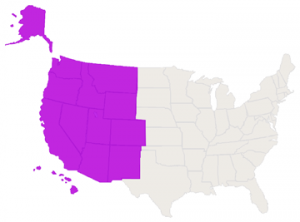 On August 11, 2016 NASJE’s Western Region hosted a meeting where we shared ways to approach teaching and facilitating discussions about the difficult topics of racism, prejudice and implicit bias in the judicial branch with judges and court staff. The documents provided by presenters can be found in the NASJE Member Area. Unfortunately, a link to the meeting recording is unavailable.
On August 11, 2016 NASJE’s Western Region hosted a meeting where we shared ways to approach teaching and facilitating discussions about the difficult topics of racism, prejudice and implicit bias in the judicial branch with judges and court staff. The documents provided by presenters can be found in the NASJE Member Area. Unfortunately, a link to the meeting recording is unavailable.Michael Roosevelt shared how he and colleagues have approached the topic recently with staff at the California Center for Judicial Education and Research (CJER), while Jason Mayo of California shared the comprehensive, long-term plan for teaching the topics there. Jesse Walker of Washington shared the outline of a judicial conference to be held next spring which revolves around the topic and different ways these issues come up in a variety of sessions over three days. The film 3 ½ Seconds: 10 Bulletforms the nucleus for the conference. Educators from five Western states participated in the web-based meeting.
-
Diversity, Fairness, and Access: A 21st Century Curriculum
By Michael Roosevelt, Senior Analyst and Judicial Educator, Criminal Justice Services, Judicial Council of California
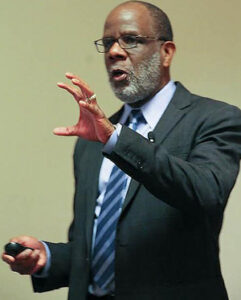
Michael Roosevelt Last year, the Education and Curriculum Committee along with the Diversity, Access, and Fairness Committee, released its newest curriculum design, The Journey toward Diversity, Fairness, and Access through Education, which is a roadmap for judicial educators and practitioners wishing to develop or integrate fairness and bias related topics. Early curriculum adopters have lauded it.
However, to more widely disseminate the curriculum, my co-faculty Karen Thorson, Consultant and former director of the Center for Judicial Education and Research for the Judicial Council of California and I introduced the membership to the curriculum in a plenary session, “NASJE’s Newest Curriculum: Diversity, Fairness, and Access”, during the 2015 NASJE Annual Conference in Seattle, Washington. The content of the curriculum design addresses fairness issues relevant to the work of judicial branch educators. The design prompts consideration of each educator’s own actions with regards to diversity, access and fairness, as well as their management of fairness courses for judges and court personnel. The goals of the session as described in the NASJE Conference program were as follows:
This plenary session has two purposes. The first is to engage judicial branch educators in an experiential learning situation to transform their perspectives and professional actions regarding diversity, fairness, and access. The second is to directly connect them to the real-world uses and practical application of NASJE’s recently adopted curriculum design on diversity, fairness, and access, which is the basis for the learning situation.
Rather than proceed methodically through each section of the design, an unsatisfying approach at best, we selected key content areas suitable for the size of the group and the time available. We frequently had judicial branch educators reference the curriculum design to make connections between selected content and delivery method. For example, before discussing bias (content), participants were asked to participate in a brief table group (delivery method) exercise requiring them to share an experience of being treated unfairly (connection).
Additionally, we encouraged participants to connect the curriculum content to the practical world inhabited by judicial educators. For example, one thing judicial educators must do is recruit faculty from diverse backgrounds. Rather than simply discuss how to select diverse faculty (content) for access, fairness and diversity courses, we modeled it: I’m African American and my co-faculty white. While we acknowledge that the availability of diverse faculty varies by state, judicial educators should, whenever possible, identify and recruit diverse faculty.
We hope, in the future, to deliver the diversity, fairness, and access content from the curriculum design as a webinar and reach those who were not able to join us in Seattle. Look for the webinar in 2016.
-
Procedural Fairness for Court Staff
By Hon. Mark Goodner, Deputy Counsel and Director of Judicial Education, Texas Municipal Courts Education Center
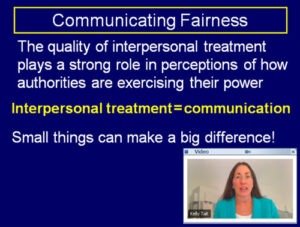 On February 25, 2016, NASJE’s Northeastern Region sponsored a webinar for NASJE members entitled Procedural Fairness for Court Staff: A Brief Curriculum for Teaching, facilitated by Kelly Tait, Immediate Past President of NASJE, and Joan Bishop, NASJE Northeastern Region Director. About 55 people participated in the webinar. It was a very quick-moving and informative exploration of how and why judicial branch educators should include the topic of procedural fairness in education programs for court personnel as well as judges.
On February 25, 2016, NASJE’s Northeastern Region sponsored a webinar for NASJE members entitled Procedural Fairness for Court Staff: A Brief Curriculum for Teaching, facilitated by Kelly Tait, Immediate Past President of NASJE, and Joan Bishop, NASJE Northeastern Region Director. About 55 people participated in the webinar. It was a very quick-moving and informative exploration of how and why judicial branch educators should include the topic of procedural fairness in education programs for court personnel as well as judges.Kelly Tait spent time up front talking about the importance of getting buy-in from court personnel when approaching the topic in an educational setting, and she offered several examples of ways that could be done. For instance, a string of video clips related to poor customer service showed how frustrating (if not infuriating) it can be when customers are not served fairly and effectively. The video clips helped to put us in the shoes of a court user who might be angered by a perceived lack of fairness. Drawing examples from the learners and using analogies such as the alienating and intimidating use of specialized medical language by health care professionals are also effective methods of letting learners know why procedural fairness is important.
The facilitators explained procedural fairness as whether or not people experiencing the justice system perceive the procedures used and the interpersonal treatment they received as fair. The aspect of “perception” in this brought to mind judicial ethics, as all court personnel must avoid impropriety as well as the perception of impropriety in the courts. Likewise, we can’t disregard the perception of the court user when evaluating procedural fairness. The four key components of procedural fairness are (1) Understanding (Is there an understanding of court and the process?); (2) Voice (Are court users being heard?); (3) Respect (Do court users feel they’ve been treated with respect and dignity?); and (4) Neutrality (Is the court providing a neutral forum?). Helpfulness was also discussed as a related aspect that is relevant to court personnel. This explanation provided a very well-rounded picture of what judicial branch educators should be concerned with when considering procedural fairness.
Procedural fairness should be exhibited (and embraced) by all members of the court staff. Court staff have more contact with court users and experience a one-on-one exchange of information. If the court and the court staff have dealt with users fairly, then those users are more likely to cooperate, be pleasant, provide information, accept decisions, comply with orders, and leave with a positive perception of the court system.
Joan Bishop discussed some of the barriers to court staff providing procedural fairness. These include personal biases and stereotypes as well as a lack of time due to a high volume of cases and people they are working with. These barriers led to some valuable discussion with webinar attendees, spurred on by questions developed by Northeastern Region members. All participants agreed that including this topic in court educational programs is vital, and participants discussed the different models, group sizes, and methods that might be most useful in talking this topic. Facilitators provided several resources including an excerpt of a toolkit for measuring perceptions of fairness by Emily Gold LaGratta of the Center for Court Innovation and a list of relevant websites and publications.
This was a useful webinar on an important topic, and NASJE thanks the Northeastern Region for sponsoring it.
A recording of the webinar, a PDF with resources, and a PDF of the content from the PowerPoint show are available in the Member Area of this website (Resources > Member Area. If you are a NASJE member and need the password, please contact Kelly Tait at ktconsulting@aol.com or Nancy Smith at nfsmith@sc.pima.gov).
-
Teaching Implicit Bias to Court Employees: Lessons from the Field
By Natalie Carrillo, Research and Evaluation Assistant, Pima County Arizona Juvenile Court, and Matthew Estes, Training and Education Coordinator, Arizona Superior Court in Pima County.
This article reflects upon the July 2015 Implicit Bias training program in Pima County, Arizona (Tucson) and offers lessons and tips that other judicial educators can use as they create their own implicit bias coursework.
Introduction
How do courts deal with issues such as the disproportion of minority representation in the criminal and juvenile justice systems? How can court employees and judges act to overcome the perception that the criminal justice system is biased towards minority populations, as shown in research at ProceduralFairness.org and elsewhere? Pima County courts chose to tackle implicit bias training as one facet of their efforts to combat these and related issues in courts in Tucson, Arizona.
The Pima County court system welcomed two national experts in the emerging field of implicit bias in July, 2015. They taught six sessions on three different court campuses in Tucson in an effort to improve staff awareness of how associations, attitudes and habits shape and affect our daily interactions with court customers and with each other.
Michael Brownstein, Assistant Professor of Philosophy at John Jay College of Criminal Justice, and Alex Madva, Visiting Assistant Professor of Philosophy at Cal Poly Pomona taught the classes. The instructors came highly recommended by those interested in implicit bias both academically and professionally.
Over 300 Court employees participated in implicit bias training at three different training locations July 22-24, 2015. The turnout was one of the largest in Court history for a training event, and drew walk-in attendance from units across the spectrum of the judicial branch, from the Pascua Yaqui tribe to the Pima County Sheriff’s Office.
What is implicit bias, and why is it tricky to teach?
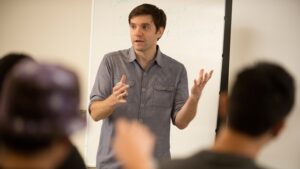
Dr. Alex Madva of Cal Poly Pomona Implicit bias arises from attitudes or stereotypes that affect our understanding, actions, and decisions in an unconscious manner. It may be helpful to think of implicit biases as unspoken stereotypes that we are repeatedly exposed to through media, social segregation, learning at early developmental stages, and normal habits of mind like categorization and heuristics.
The Stanford Encyclopedia of Philosophy invites us to consider the plight of “Frank” when defining implicit bias:
Frank … explicitly believes that women and men are equally suited for careers outside the home. Despite his explicitly egalitarian belief, Frank might nevertheless implicitly associate women with the home, and this implicit association might lead him to behave in any number of biased ways, from trusting feedback from female co-workers less to hiring equally qualified men over women.
Brownstein, M. (2015, February 26). Implicit Bias. Stanford University. Retrieved from http://plato.stanford.edu/entries/implicit-bias/
While implicit biases often lie deep within our subconscious minds, their effects have been found to have stark consequences. Researchers have found implicit biases affecting behavior negatively across the spectrum of social interaction. In recent studies, problematic implicit biases appear to cause unfavorable judgment of minority job applicants, and even lead to harsher sentences for inmates with more “Afrocentric” facial features.
The topic of implicit bias is both new and nuanced. Trainers who are preparing court audiences for their initial encounter with implicit bias should prime their audience before the class. Examples of helpful priming include detailed course descriptions and emails with links to academic resources. Trainers who know their audience may consider inviting participants to attempt one of several online exercises that promote awareness of implicit bias, which is an effective way to get participants talking about it.
How can a trainer build an implicit bias class that meets his/her courts’ specific needs?
In our sessions, Drs. Brownstein and Madva explained the theory of implicit bias, how social scientists became interested in studying it, why implicit bias is an important concept for court employees to understand, and what strategies can be employed to combat it in the courts and in everyday life.
We came to know our instructors very well over the several months we spent planning and executing the July training, and learned that their implicit bias research interests lie at the intersection of the ethical implications of our subconscious mental attitudes and the research of psychologists interested in social cognition. And while Drs. Brownstein and Madva were excited to discuss their scholarly interests upon inquiry, they were also extremely capable of using everyday language and real-world examples to ensure that all attentive participants could understand and apply the lessons of implicit bias research.
Our instructors’ examples and explanations centered on the Implicit Association Test (IAT), which detects the strength of a person’s association between representations of objects or concepts that the mind organizes into different categories. Drs. Madva and Brownstein presented an array of research results from the IAT that indicate the existence of troubling bias against members of certain racial, gender, and other social groups.
Our deliberate focus on the IAT was a direct result of observation of our audience in previous situations. Years of course evaluation responses show that Pima County court employees find arguments with relevant statistical data more persuasive than arguments without such data. This type of activity also helps participants understand the power of association without the feeling of judgment that can be involved in other discussion. Other audiences may find IAT data too rudimentary, in which case a deeper discussion of policy implications might be preferred.
Why did we decide to offer Introductory and Advanced level classes?
Drs. Brownstein and Madva presented two levels of implicit bias training. The introductory class was designed for the court employee who had little previous experience with implicit bias or none at all. Titled “Understanding Implicit Bias: The Causes and Effects of Implicit Bias in Criminal Justice and Education,” the introductory class provided a thorough historical overview of implicit bias, followed by an explanation of what the IAT is and how it works. An interactive class exercise completed the content in the first hour. In the second hour of the class, the instructors explained the negative outcomes predicted and explained by the IAT, and concluded with a brief discussion of reforms that could be made in light of implicit bias findings.
The advanced class, titled “Overcoming Implicit Bias: Individual and Institutional Reforms,” started with a condensed version of the introductory class. The remaining 90 minutes were devoted to a deeper exploration of potential reforms, and more in-depth group discussion of those reforms.
We had anticipated that participants would self-sort into the Introductory and Advanced classes based upon the descriptions we provided in training bulletins and emails. However, that turned out not to be the case. Some court employees who had a strong understanding of implicit bias attended the introductory session, and many court employees attended both the introductory and advanced classes. In both cases, we received constructive feedback on the course evaluation forms that parts of the class felt somewhat rudimentary, or repetitive. Upon reflection, the advanced class would have been more effective for the audience had we chosen to present completely new content from the introductory class. This would have allowed Drs. Madva and Brownstein to delve deeper into ideas for institutional level reforms among other things.
What methods helped us to obtain useful data from the implicit bias trainings?
The idea for implicit bias training originated from a recommendation for a project to help reduce disproportionality in the juvenile justice system in Pima County, Arizona. Due to the nature of the project, it was important to gauge whether the trainings had any measurable effect on the participants. We considered what type of measurement would not only measure change in participant responses, but also provide participants with an opportunity to provide feedback and suggestions for future trainings.

Dr. Michael Brownstein of the John Jay School of Criminal Justice Participants took part in three surveys. The first survey was completed prior to the training, the second immediately following the training, and a third survey was sent to them three months after the training. The same tool measured participant responses to the same statements before and after the training. Drs. Brownstein and Madva recommended a tool used in a previous study to measure implicit bias education. The third survey was online and assessed whether participants found the training useful and also provided a forum for feedback and suggestions. The surveys showed that the training raised participants’ awareness of implicit bias and its effects on their decision-making.
What did participants think about the implicit bias trainings?
Court employees found Implicit Bias training to be provocative, informative and pertinent to their employment. One attendee wrote that the instructors “did a very good job presenting the information on a topic that can be difficult.” Another recognized “that you have to stretch your mind to be constantly aware of your own biases.”
Several thoughtful attendees asked about the IAT design itself, as response times that lag by mere tenths of a second are deemed significant. Drs. Madva and Brownstein explained that the IAT is one of the most widely used and reviewed tools in social science research. While they did not proclaim any definitive causal links between implicit bias research and prejudiced attitudes, the professors did explain how and why implicit bias is an emerging explanation for the persistence of racist and discriminatory attitudes in twenty-first century America.
As mentioned above, we anticipated that the topic of implicit bias would create some confusion and uneasiness in our audience. And while we did receive some commentary to that effect (“A study can be made to find whatever statistics we want”; “It’s a ridiculous concept meant only to divide and create negative feelings among the masses”), these comments represented a small subset of the larger group. A much larger cluster of comments indicated that participants found the training to be provocative, supported by helpful statistics and useful research, and that the training could be practically applied in the court environment.
How are we keeping up the momentum?
The July implicit bias training was well-received in the aggregate, and the high-quality instruction provided by Drs. Brownstein and Madva has had positive effects on the progress of similar coursework. Current and future coursework on the topic of implicit bias is a high priority, given that one of the instructors’ key takeaways was that “debiasing” is more likely to happen in an environment where implicit bias education is emphasized and frequent. As Court educators know all too well, the lessons of a great training begin to scatter and dissipate if they are not followed by classes on similar topics, with similar themes.
In November, 2015 Court employees were invited to participate in “American Denial,” a class which used a PBS documentary of the same title to explore the impact of implicit bias in a smaller setting. The smaller class afforded trainers the opportunity to solicit more feedback from the participants, and future offerings of the class will provide scenarios with examples of implicitly biased action for participants to consider. Another class, which uses the film Fruitvale Station as a basis for discussion, also puts forth the concept of implicit bias and its relationship to prejudice and racism. Both of these classes will be offered throughout the coming year in an effort to maintain awareness of the impact of implicit bias in the criminal justice system.
Moving forward, discussions are underway to provide more opportunities for Court employees to encounter and wrestle with implicit bias topics. We also plan to use the suggestions and feedback from our employee surveys to develop future trainings.
[For further information, an Implicit Bias Resource Guide is posted in the members-only area.]
Sources
- Brownstein, M. (2015, February 26). Implicit Bias. Stanford University. Retrieved from http://plato.stanford.edu/entries/implicit-bias/
- Project Implicit. (2011). Harvard University. Retrieved from https://implicit.harvard.edu/implicit/takeatest.html
About the authors
 Natalie Carrillo is a Research and Evaluation Assistant at Pima County Juvenile Court (Tucson, AZ) where she works on the Disproportionate Minority Contact Intervention Project among other court projects. Prior to joining the Court, she worked in education for over ten years. She earned a Bachelor’s degree in History from The Colorado College, and a Master’s in Public Policy from Johns Hopkins University.
Natalie Carrillo is a Research and Evaluation Assistant at Pima County Juvenile Court (Tucson, AZ) where she works on the Disproportionate Minority Contact Intervention Project among other court projects. Prior to joining the Court, she worked in education for over ten years. She earned a Bachelor’s degree in History from The Colorado College, and a Master’s in Public Policy from Johns Hopkins University. Matthew Estes is a Training and Education Coordinator for the Arizona Superior Court in Pima County. In that role, he brings trainings to judicial staff across many different platforms, and works specifically with juvenile detention and probation staff to meet their training needs on a case-by-case basis. Previously, Matthew was an instructor and curriculum designer at the high school and community college levels.
Matthew Estes is a Training and Education Coordinator for the Arizona Superior Court in Pima County. In that role, he brings trainings to judicial staff across many different platforms, and works specifically with juvenile detention and probation staff to meet their training needs on a case-by-case basis. Previously, Matthew was an instructor and curriculum designer at the high school and community college levels. -
Oxford Dictionary of Sociology
Oxford
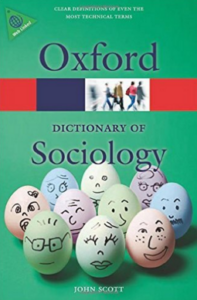 Dictionary of Sociology by John Scott
Dictionary of Sociology by John Scott
Get it at AMAZONA consistent best-seller, the wide-ranging and authoritative Dictionary of Sociology was first published in 1994 and contains more than 2,500 entries on the terminology, methods, concepts, and thinkers in the field, as well as from the related fields of psychology, economics, anthropology, philosophy, and political science. This Dictionary is both an invaluable introduction to sociology for beginners, and an essential source of reference for more advanced students and teachers.
-
Inviting Transformation: Presentational Speaking for Changing the World
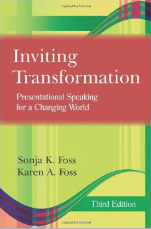 Inviting Transformation: Presentational Speaking for Changing the World by Foss & Foss
Inviting Transformation: Presentational Speaking for Changing the World by Foss & Foss
Get it at AMAZONThe third edition of Inviting Transformation continues to offer a refreshing, innovative approach to public speaking, or what the authors call presentational speaking to acknowledge that not all important speaking occurs in formal public settings. The book introduces readers to invitational rhetoric, a mode of communicating that offers an effective response to the diversity that characterizes the world.
Respect for the diversity of the world also is emphasized in the book in that the traditional speaking model has been expanded to include speaking options that characterize diverse cultural groups. For all of the processes of presenting — such as selecting a speaking goal, organizing ideas, elaborating on ideas, and delivering the presentation — the book includes and validates more inclusive speaking practices.
The exceptionally accessible writing style and reasonable price make this concise text attractive for students and instructors alike.
